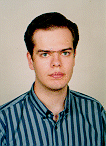

|
SSP Project Summary: |
|
|
|
In a previous MSc project, Grove [1995] developed an iconic object recognition system. A key aspect of the foveation subsystem was the extraction of image features from a foveated representation (ie. where image pixels represent smaller portions of the image the closer to the centre of the image). The other key aspect of the foveation subsystem was the transformation from a cartesian to a radial representation, which has advantages in matching (in providing a mechanism for scale and rotation invariance).
Grove's system then extracted a set of features based on Marr's primal sketch: bars, edges, corners and blobs. These were extract from 3*3 neighbourhoods of the iconic image, using a hard-coded pattern match. These features were matched to a set of stored model features, with a serious of permutations to allow scale and rotation invariance.
In testing Grove's program, it was found that it took about 30 seconds to process each foveation on the fastest department machine at that time (twain). This was adequate for small scale testing, but means that there is not much hope of real applications until a factor of 100 increase in speed per foveation point is achieved. Much of the time required is in the actual foveation process.
This project will investigate a parallel re-implementation of the existing project, in either a SIMD or a MIMD mode.
A SIMD mode is suggested as each pixel in the foveal image can be computed effectively in parallel, although requires input image regions of varying size. However, once that is done, feature extraction is done independently on each pixel, as is most of the matching. Thus, a lot of processing over the 25*64 foveal image can be done in about 1000-way parallel.
On the other hand, MIMD processing should also be possible as each feature plane can be extracted independently, and each model/scale/orientation setting can be matched independently. Each of these processes could be assigned to an independent processor.
While there is plenty of opportunity for distributing processing, doing so without an excessive communication overheads will probably be the key problem of either approach to the project.
The main steps to the project are:
 Paulo
Marques worked on this project.
Paulo
Marques worked on this project.
Compressed PostScript of the project's final report will be available here (744 bytes) .
 Webpage maintained by
mario@epcc.ed.ac.uk
Webpage maintained by
mario@epcc.ed.ac.uk
|